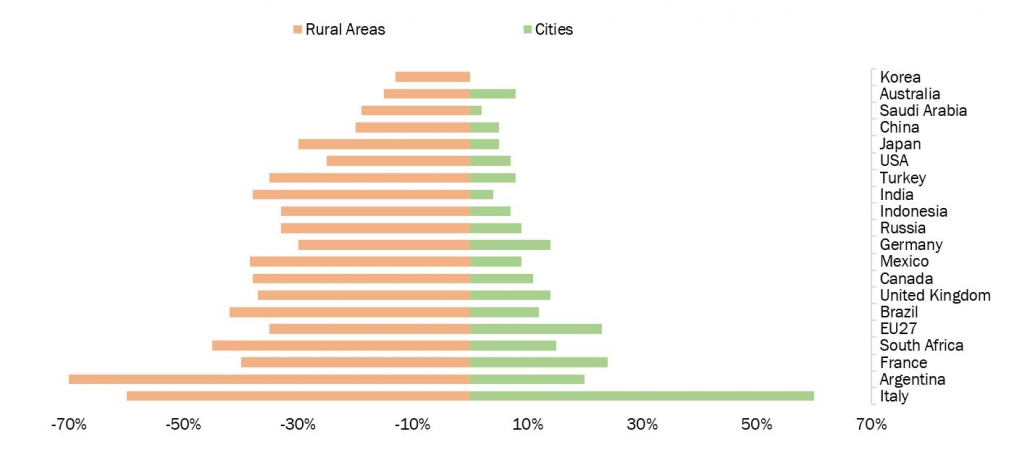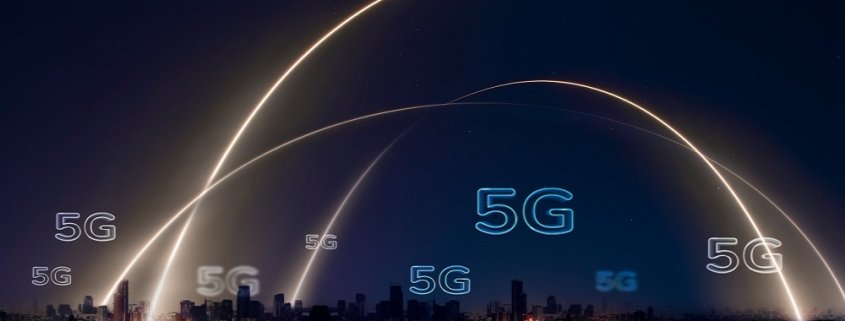5G NTN Evolution: Advancements and Breakthroughs in Connectivity
NTN enables connectivity in areas that were formerly inaccessible by terrestrial networks, regardless of whether it be over terrain, or deserts, among others. It accomplishes this by using satellites as well as non-terrestrial vehicles. The capacity to operate in disaster zones and drive potential technologies such as UAMs. Furthermore, by tackling coverage issues and advanced applications that ground-based architecture alone cannot solve, satellites may complement 5G and increase the economic impact of 5G networks.
- Current Types Of Satellite-Based NTN Systems
The backhaul of mobile network services via GEO and MEO networks makes up the majority of the currently operational satellite-based NTN systems. These cellular offerings, which might be 3G/4G or 5G, might be offered in rural locations where traditional backhaul technologies are challenging to set up because of the terrain, distance, or expense. Due to the higher latency brought on by the greater satellite distance, 3G/4G backhaul across the current MEO/GEO satellites has historically proved difficult.
Satellite-Based NTN Platform Types
|
Platforms |
Altitude Range (in Km) |
Typical Beam Footprint Size (in Km) |
|
LEO |
300 – 1,500 | 100 – 1,000 |
|
MEO |
7,000 – 25,000 |
100 – 1,000 |
| GEO | 35,786 |
200 – 3,500 |
Source: 3GPP
In the above table, three-type of satellite-based NTN platforms are mentioned. Numerous Internet of Things (IoT) applications that can be supported by LEO and GEO utilize NTN technology, especially in distant and difficult-to-reach places. For instance, to democratize the availability of the Internet of Things, Sateliot, the first firm to run an LEO nanosatellite constellation using the 5G-IoT standard, debuted Sateliot_0 “The GroundBreaker” in April 2023.
Additionally, ZTE has collaborated with China Mobile to perform the pilot test using the GEO satellite, taking into account the market demands for space IoT and the significance of NB-IoT NTN applications. To send air-interface messages, an L-band satellite, and terrestrial gateway station are situated between NTN endpoints and base stations.
- 5G NTN Spectrum
Various frequency bands are presently being studied for NTN following 3GPP. Several are above 10 GHz and in FR2, while others are in the FR1 legacy band. The FR1 frequencies under consideration right now for NTN are the S-Band (n256) and the L-Band (n255).
5G NTN Spectrum (FR1 and FR2)
| Band | Uplink | Downlink | Duplex | |
| First 3GPP NTN FR1 bands for L-Band and S-Band (IoT) | n255 | 1626.5 – 1660.5 MHz | 1525.0 – 1559.0 MHz | FDD |
| n256 | 1980.0 – 2010.0 MHz | 2170.0 – 2200.0 MHz | FDD | |
|
Existing 3GPP FR2-1 Bands |
n257 | 26.50 – 29.50 GHz | 26.50 – 29.50 GHz | TDD |
| n258 | 24.25 – 27.50 GHz | 24.25 – 27.50 GHz | TDD | |
| n259 | 39.50 – 43.50 GHz | 39.50 – 43.50 GHz | TDD | |
| n260 | 37.00 – 40.00 GHz | 37.00 – 40.00 GHz | TDD | |
| n261 | 27.50 – 28.35 GHz | 27.50 – 28.35 GHz | TDD | |
| n262 | 47.20 – 48.20 GHz | 47.20 – 48.20 GHz | TDD | |
| Proposed 3GPP NTN FR2-0/FR2-1 bands * for K-Band and KA-Band (VSAT) | n510 | 17.70 – 20.20 GHz | 27.50 – 28.35 GHz | FDD |
| n511 | 17.70 – 20.20 GHz | 28.35 – 30.00 GHz | FDD | |
| n512 | 17.70 – 20.20 GHz | 27.50 – 30.00 GHz | FDD |
Source: 3GPP, Rohde & Schwarz
Major corporations are working together to optimize GEO and NGSO multi-orbit systems to deliver seamless, global availability for D2D application scenarios across significant verticals, namely consumer mobile device, automobile, and Internet of Things (IoT) connections. In February 2023, for instance, to provide the most advanced space-based D2D technologies for international voice, text, and data accessibility, Omnispace, and Ligado Networks declared an MOU that will merge their respective licensed mobile satellite network range. The partnership paves the way for the establishment of multi-band, multi-orbit satellite services that will allow common mobile communication for over five billion mobile subscribers in regions where terrestrial mobile service is currently insufficient. These satellite offerings will utilize huge portions of satellite bandwidth in the L- and S-Bands.
- Vast 5G NTN Use Cases
In terms of worldwide network coverage, terrestrial cellular networks do not reach over eighty percent of land and approximately 95% of maritime regions. Smartphones and Internet of Things (IoT) terminals can be combined with terrestrial cellular networks and directly linked to satellites via 5G NTN. This makes it possible to construct and uphold a consolidated network with widespread connections, an abundance of scenarios, firmly linked industry chains and decreased O&M expenses. Emergency connectivity, mining, oil and gas, electrical systems, maritime issues, shipping, animal welfare, and agriculture are just a few areas where 5G NTN can be extensively used.
As a result, prominent companies are proactively developing cutting-edge technologies to leverage the extensive range of application scenarios presented by 5G NTN. An illustrative example is the joint effort of TTP and AccelerComm, leading companies in layer 1 5G IP and autonomous technology, respectively, to develop an advanced 5G LEO Regenerative base station for installation on Low Earth Orbit (LEO) satellites. The project proposes a specific 5G regenerative gNodeB solution designed to provide outstanding performance 5G connectivity in the demanding NTN environment, combining the experience and intellectual property (IP) from the two firms with extra technology from collaborators.
Another instance is the initiative taken by Samsung in February 2023 to precisely forecast satellite positions and reduce frequency offsets brought on by the Doppler shift using its Exynos Modem 5300 reference system for highly dependable NTN connectivity with LEO satellites. Future Samsung Exynos modems will offer two-way text messaging and high-resolution image and video sharing owing to this technology.
- Satellite-Based Connectivity
According to research by RMIT University, mobile data speeds in Australia’s remote regions with sizable Indigenous populations were 90% slower compared to those in urban regions. Similarly, as per OECD, in rural regions, fixed broadband download speeds of EU and G-20 nations are roughly 50% slower compared to speeds in urban cities.
Digital Divide As Measured By Fixed Broadband Download Speeds (Q4,2020)

Source: OECD
Consequently, the use of satellite-based connectivity could be crucial in utilizing existing communication networks to provide 5G capabilities in the coming years and narrow the digital gap. For instance, Coverage Above and Beyond, a ground-breaking new proposal to offer cell phone service anywhere, was unveiled by T-Mobile and SpaceX in August 2022. T-Mobile intends to offer nearly full coverage in the majority of locations in the United States, including many of the remotest regions that were previously inaccessible by conventional cell signals. It aims to accomplish this by utilizing Starlink, SpaceX’s LEO satellites, and T-Mobile’s sector-leading wireless network.
- Leading Players
Several companies such as Space X, Inmarsat, and others are actively researching and creating solutions for the 5G NTN (Non-Terrestrial Network) industry, which is still in its nascent stage. A few of the major companies in the global NTN market are mentioned in the table below. These businesses are making investments in research, development, and use of 5G NTN capabilities to take advantage of the possibilities of extraterrestrial networks for enhancing connectivity and communication capabilities. Below are some of the major developments:
- Space X – In 2022, the international satellite-to-cellular network initiative “Coverage and Above and Beyond,” a joint venture between SpaceX and T-Mobile, was launched. The firms presented strategies for extending 5G coverage using second-generation Starlink satellites to eliminate mobile dead zones, such as in remote locations in the middle of the ocean. The two businesses announced recently that they will start piloting 5G connectivity in the latter half of 2023.
Major Broadband and Satellite Providers, 2023
|
Operator |
Satellite system (deployed) | Spectrum | Operational | Services |
|
Space X (Starlink) |
12,000+ (3,580) | Ku-band | Yes | Broadband |
| Kuiper | 3236 (0) | Ka band | Estimated 2024 |
Broadband |
|
Echostar |
10 GEO (10) | Ku, Ka, S bands | Yes | Broadband |
| HughesNet | 3 GEO (2) | Ka band | Yes |
Broadband |
| Inmarsat | 14 GEO (14) | TBD | TBD |
Broadband to IoT |
Source: 5G Americas
- Kuiper Systems LLC – Amazon’s Project Kuiper aims to provide global internet access to users using a fleet of LEO satellites. In 2024, Amazon is anticipated to launch its first batch of satellites, and later that year, it is expected to start offering service to its first clients. It is yet unknown where Project Kuiper will launch its internet service and how much it will cost consumers.
- EchoStar Corporation – In February 2023, satellite provider EchoStar stated it would begin constructing a constellation of 28 LEO satellites around the world alongside supplier Astro Digital. These satellites will broadcast signals using the business’s S-band spectrum ownership. For IoT applications, the system will at first support the LoRa protocol, but EchoStar claimed that this move is a component of a long-term plan to create “a worldwide non-terrestrial 5G network.”
- Inmarsat – To deliver ultra-reliable, two-way satellite connectivity for smartphones, IoT devices, cars, and other sectors, MediaTek and Inmarsat strengthened their alliance as of April 2023. The two major players in the industry are working to make it possible for mobile carriers, smartphone makers, and additional device manufacturers to deliver satellite offerings, such as two-way text messaging, disaster communications, device monitoring, and surveillance, amongst other features. The MediaTek/Inmarsat partnership offers the industry a very practical strategy by utilizing tried-and-tested 5G NTN guidelines, current chipsets, and the most dependable universal satellite infrastructure, enabling a speedy rollout of new NTN services.
Conclusion
In conclusion, 5G NTN is a revolutionary technology that can reinvent satellite communication. With its capacity to deliver dependable and fast connections in remote and rural locations as well as its potential applications in a variety of sectors, 5G NTN is positioned to play a significant role in determining the direction of connectivity in the coming years.
Due to rising demand for better accessibility to networks, data-intensive applications, and IoT devices, this market is expanding significantly. Major firms in the market are making significant investments in the creation of cutting-edge technologies to take advantage of the wide range of application scenarios provided by 5G NTN.
Find some of our related studies:
- 5G Network Security Market: https://www.knowledge-sourcing.com/report/5g-network-security-market
- 5G Network And Service Assurance Market: https://www.knowledge-sourcing.com/report/5g-network-and-service-assurance-market
- Global 5G Device Market: https://www.knowledge-sourcing.com/report/global-5g-device-market



